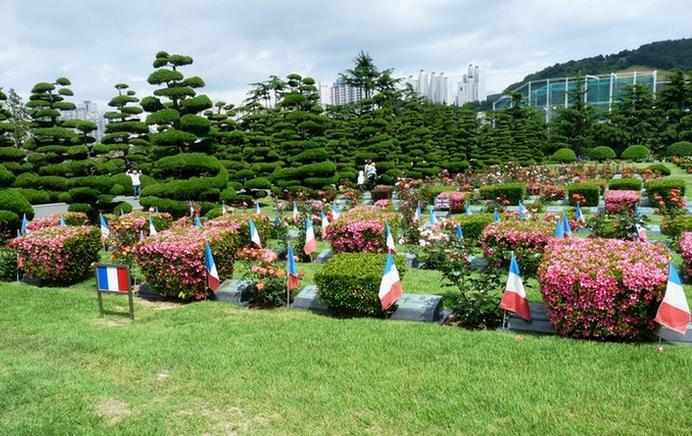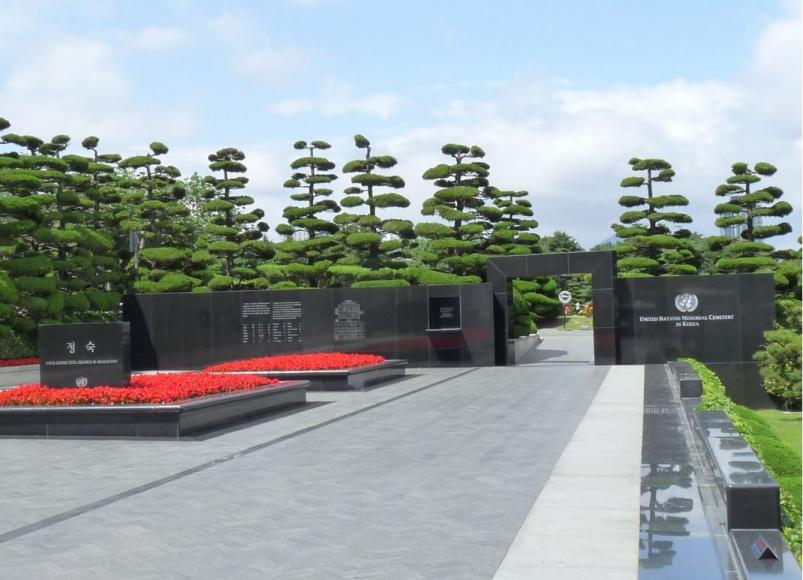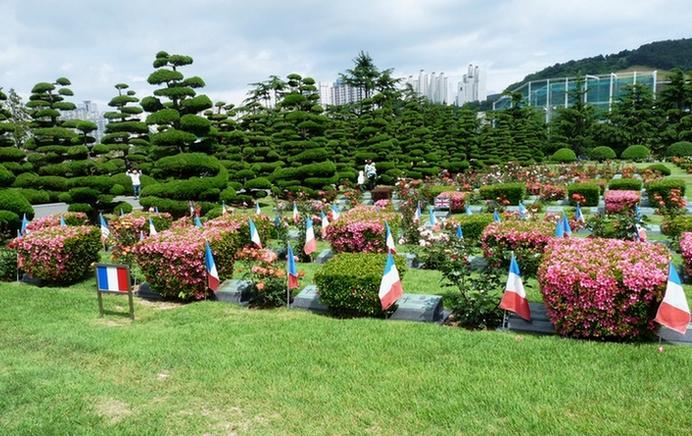French military graves in South Korea

Sépultures françaises en Corée du Sud
On 9 August 1945, the Soviet Union and the United States shared out the occupation of Korea, liberated from the Japanese, the Soviets taking the north and the Americans the south. At the time, it was seen as a temporary measure, each side keen to see the reunification of the peninsula.
On 25 June 1950, North Korea, backed by the USSR, invaded South Korea without warning. The UN Security Council, from which the Soviet representative happened to be absent, met urgently the following day, condemning the aggression and authorising the use of force in support of South Korea. It was the start of an international intervention that would last three years.
France deployed a military unit comprised of volunteers, the “French Battalion”, initially under the command of a prestigious military figure and hero of Free France, General Raoul Magrin-Vernerey, aka Monclar, who agreed to temporarily revert to the rank of lieutenant-colonel for the purpose. Incorporated in the US 2nd Infantry Division, the battalion saw fierce fighting and received several citations.
On 27 July 1953, the armistice signed between the belligerents brought a return to the status quo and the division of Korea either side of the 38th parallel.
The conflict had resulted in over two million dead. Of the 3 421 members of the UN French Battalion, 269 were killed, including 18 Koreans in the battalion, 1 350 were wounded and 12 were taken prisoner. A further seven soldiers were reported missing.
The bodies of the dead French soldiers were repatriated, except for 44, who were buried in the UN Memorial Cemetery in Busan, presented here.

Le cimetière des Nations-Unies de Pusan
The only United Nations cemetery anywhere in the world (Resolution 977 of 15 December 1955), the UN Memorial Cemetery in Korea is a unique remembrance site.
In January 1951, various battlefield cemeteries that had grown up behind the lines were concentrated at Tanggok, a suburb of Busan. The land for the cemetery was granted to the United Nations by the Republic of Korea as a tribute to all those who had laid down their lives in combating aggression and in upholding peace and freedom.
There are national sections marked by flags, and the graves have permanent headstones, each with a bronze plaque giving the name and unit of the deceased. The cemetery contains 2 300 individual graves.
The section containing the French graves covers an area of 230 m² and is marked with the number 27 on the cemetery map. It contains 44 individual graves consisting of a concrete base topped with a bronze plaque. Before the French plot, a monument in black granite with a large bronze plaque has been erected.
At the far end of the UN Memorial Cemetery, a plot has been specially created for any French Korean War veterans wishing to be buried here. The first, Raymond Bénard, was buried here on 15 May 2015 and the second, André Bélaval, on 27 October 2016. The third veteran, Jean Lehoux, was buried on 2 November 2017 near the memorial to the Battle of Arrowhead.
The cemetery is managed by a commission, consisting of 11 member nations (Australia, Canada, France, Korea, Netherlands, New Zealand, Norway, South Africa, Turkey, UK and USA) whose fallen during the Korean War are interred here
France, through the Ministry of the Armed Forces/Directorate for Heritage, Remembrance and Archives (DPMA), provides approximately € 12 000 in funding annually for the preservation of the site and the upkeep and improvement of the French military graves.

Carré militaire français de Pusan
(@DR)
The other remembrance sites in honour of French servicemen in South Korea
With the exception of the French burial plot at Busan, the other remembrance sites in Korea are maintained either by the local authorities or by the bodies responsible for managing the public spaces where they are located.
On the initiative of the French Embassy in Korea and the National Association of Veterans and Friends of the French Forces of the UN, in 2007 a remembrance trail was created, consisting of commemorative stones and plaques listing the places where the battalion was stationed and fought. The government of the Republic of Korea and a number of Korean local authorities contributed to the initiative.
The Korean government erected a memorial to French servicemen, in Suwon, which was officially unveiled in 1974 and renovated in 2013. The memorial is in the form of an open-air theatre with an esplanade, ending in a wall on which are inscribed the names of the 251 French servicemen killed in action and the 18 Korean soldiers who fought alongside them. On either side are the insignia of the French Battalion and the US 2nd Infantry Division. On the right and left of the esplanade are period photographs telling the battalion’s epic story. At the entrance to the memorial, visitors are met by an engraved stone in honour of the French servicemen. It is topped with four statues of soldiers in period uniform. “We will never forget those who came to our aid. The glory of the UN French Battalion in the Korean War must not be forgotten.”
At Hongcheon, there is a monument in honour of military doctor Major Jules Jean-Louis. It comprises a concrete wreath surmounted by a bronze statue of a French officer in combat fatigues, beret, belt and boots, who appears to be marching fearlessly towards his fate. Beneath the statue is the diamond-shaped insignia of the UN French Battalion. On the rear of the monument are two other plaques, one displaying a text in Korean, the other its French translation:
“The Korean War began on 25 June 1950, when the Communist forces invaded the south by surprise. Responding to an appeal to safeguard its freedom, France sent troops to fight in Korea. Major Jules Jean-Louis was a military doctor. He arrived on 29 November 1950 to head the UN French Battalion’s medical service. On 8 May 1951, aged 34, Major Jean-Louis fell on the field of honour while saving the lives of Korean soldiers wounded in the fighting at Jang Nam Ri. His heroic sacrifice for freedom and the humanitarian ideal, which he embodied when performing his duties and in particular when serving the civilian population encountered along the way by the battalion, shall always be remembered by the inhabitants of this country.
As we commemorate the centenary of diplomatic relations between France and Korea, this monument is erected with support from the Governor of Kangwon Province (Gangwon-do), on the very spot where Major Jean-Louis died, so that the memory of this generous soul will live on forever.
25 October 1986, Head of Hongcheon County. “
At the War Memorial of Korea, in Seoul, a commemorative plaque and pillar recall the UN French Battalion’s participation in the Korean War.
A sign of the importance to France and South Korea of remembering the Korean War, the two countries are signatories of a memorandum of understanding on remembrance cooperation, dating from November 2003. This makes South Korea the first country to have signed a document of this type with France.

